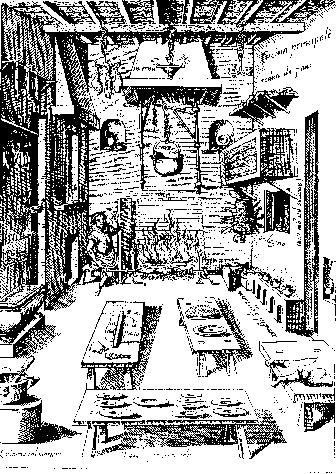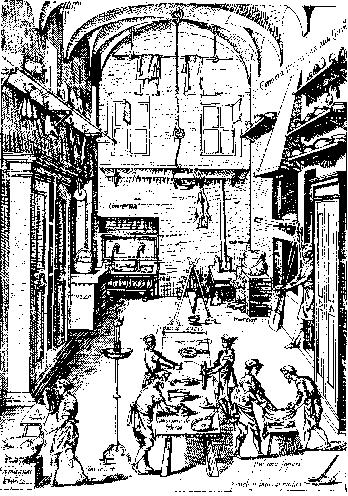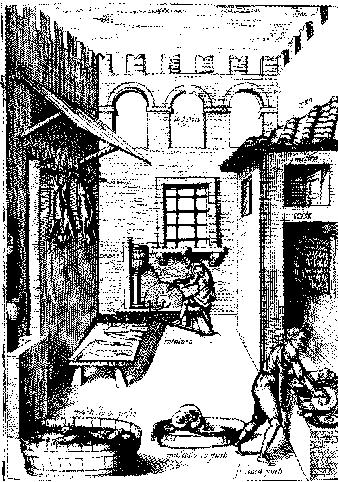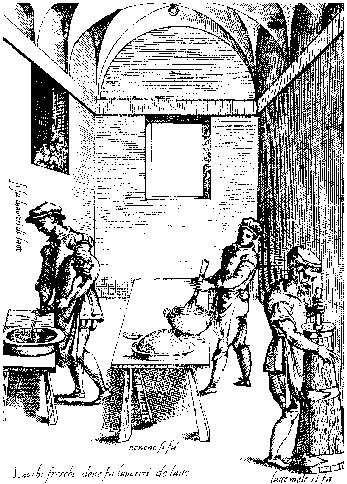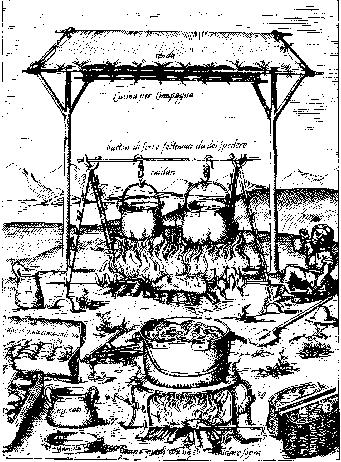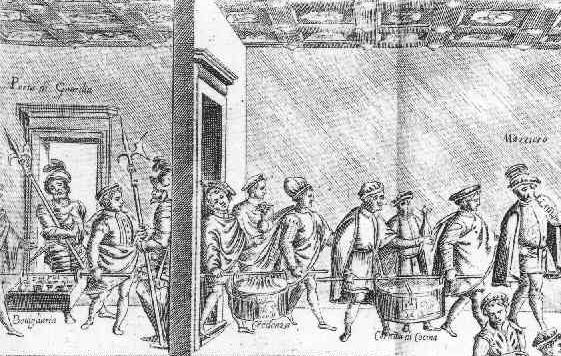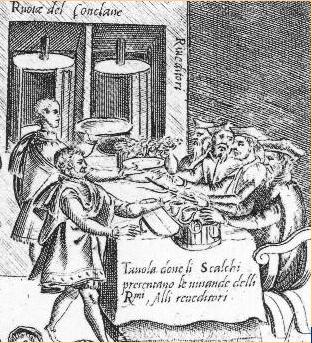
Candida Martinelli's Italophile Site

Main
Page This family-friendly site celebrates Italian culture for the enjoyment of children and
adults. Site-Overview
The kitchens in
the basement of Caterina de' Medici's French Castle Chenonceau are
wonderfully preserved, as you can see here in these images I made on
a recent visit. The butcher's block with knives and the drawer in
the bottom for blood and bits that were used for sausages. The
hooks are for hanging fowl and other meats.
Another butcher's block, well-used, with the handy
drawer underneath.
One of the hearths with cooking pots hanging, and
the table full of produce.
The bread oven with bread forms and a ready supply
of wood.
If you step back, you can see the bread paddles,
the same type that are used by pizza makers around the world.
Here you can see that the bread oven sit next to a
cooking hearth.
The sink with a pump that pumps water from the
River Cher below.
I also have on my site An Al Andalus Cookbook, or an
Anonymous Andalusían Cookbook,
as copied by a scribe in the 1400s, from texts from the 1200s, that
often were themselves transcriptions of books from the 900s.
The PDF is featured on another page on this
website, which provides more information on this book and the
recipes, which have
direct links to Sicilian cooking, and indirect links to Italian
cooking. The rest of this page refers only to the 3 Italian
books mentioned above.
There is a
wonderful book about the customs of the Middle Ages and the
Renaissance that includes many images, and tons of curious
information.
It is available to read on-line via Gutenberg Press, for free.
English
Translations Available On-Line
Some images from Scappi's
Book
The University of Marburg in Germany provides rough text
transcriptions (links
at bottom of page) of three ancient Italian cookbooks. I've
converted these texts into more useful indexed and edited PDF books that
you can access and download. Anonimo Toscano,
Libro
della cocina Anonimo Veneziano,
Libro
di cucina/
Libro per cuoco This
text is from the Veneto area of Italy from circa 1430. It is 29 pages
long and incorporates many of the recipes from the Toscano book.
The Italian is rich with French, Spanish and Latin influences, and
transliterations of the Venetian dialect's soft consonant
pronunciation. Later in about 1550, a
cook, Bartolomeo Scappi, put together another cookbook, which again
incorporated many of Maestro Martino's recipes, re-written.
The book was reprinted for over 100 years. (images
from the book below) (link
to scanned copy below).
I also have on my site An Al Andalus Cookbook, or an
Anonymous Andalusían Cookbook,
as copied by a scribe in the 1400s, from texts from the 1200s, that
often were themselves transcriptions of books from the 900s.
The PDF is featured on another page on this
website, which provides more information on this book and the
recipes, which have
direct links to Sicilian cooking, and indirect links to Italian
cooking. The rest of this page refers only to the 3 Italian
books mentioned above. These books are fun reads. They're written in an Italian that
is a mix of Italian and Latin and sometimes French and Spanish.
The local dialect and pronunciation is written
phonetically. For example, in the Venetian cookbook, the soft
Venetian pronunciation of 'gg' and 'ci' (friggere, braccia) in
Italian is written as 'z' and 'x' respectively (frizere, braxa).
And the soft French ç is used to signify a soft pronunciation in a
word like dolce, becoming dolçe (dolsay).
It makes it easier to understand if you know any of these languages
besides Italian.
Try reading the words aloud phonetically, and listening to them.
They often sound like modern Italian, but are just written with a
different spelling. The spellings vary. The masculine and feminine of the words
vary. And the words vary sometime even within one book. This
is because languages were not yet categorized and documented by
national governments and policed by language departments, and most
importantly, each book was not
the work of one author. It's best to think of the books as notebooks contributed to on
loose sheets of parchments by visiting or permanent cooks in
large feudal-style or manor house kitchens. That's why most of them are
attributed to an 'Anonymous' cook from a general region of Italy,
and include instructions at the end of many recipes to 'now serve
the dish to the Lord of the Manor' (da' al Signore). They were eventually gathered together, edited, and printed,
resulting in these cookbooks.
The regional distinctions of the anonymous authors really have little meaning. Each
book cites recipes from other European regions and even from North
Africa. Actually, many of the recipes have similar versions in
North African cooking, and many of the ingredient names are
bastardizations of North African words. This was not a time of
the modern nation-state, but instead it was a feudal period that evolved into Prince-run-states,
some enlightened by the Italian Renaissance (Rinaciamento). People, especially
tradesmen like master chefs, were very mobile. Even
Leonardo da Vinci offered his services to the chef of Ludovico di
Sforza in Milan to make his banquets more exciting with pyrotechnics
and robots, as described in this book.
Reading the books, you discover
not just traditional dishes and variations you might never have
imagined, but also things about the time period, the social
history. For
example:
Spices are used individually in the recipes, but most often, similar to all European cooking from that time,
they use spice mixes called 'sweet
spices' and 'strong spices', and sometimes 'fine spices'. These mixes are most comparable to today's
spice mixes for stuffing, pumpkin pie, pasta, etc. and the Asian 5 and 7 spice mixes,
for example, and the various curry spice mixes throughout
India.
Food back then was often strong and pungent, or sweet and sour, so
the recipes call for lots of spices, and suggest the cook cater to
the tastes of the Lord of the Manor, his patron. The mixes usually included various combinations of: In some parts of Europe, the sweet mix includes sugar,
but not in the Italian recipes. To give an idea of the mixes,
here are translations of the recipes from the Venetian cookbook. Sweet Spice Mix Sweet spice mix for many things good and fine.
The best sweet, fine spice mix that you can make if you want it for
lampreda (ed. eel-like fish) in a crust and for other good fresh water
fish that you make in a crust and for making good broth and good
flavors/sauces. Take a quarter ounce of cloves and an ounce of
good ginger and take an ounce of ground cinnamon and take the same
amount of bay/laurel leaf and grind together all these spices as
finely as you wish. And if you want to make more, take the
things in the same proportions, and it is wonderfully good. Strong Spice Mix Black and strong spices for much flavor/sauces.
Take an eighth of an ounce of cloves and two ounces of pepper and
take the same amount of long pepper and two ounces of nutmeg and
grind them all together into your spice mix. Fine Spice Mix Fine spice mix for many things. Take one ounce of pepper and one of cinnamon and
one of ginger and an eighth of an ounce of cloves and one quarter of
saffron. Spice mixes, just like in India today, also were combined to
create not just a certain flavor in food, but also a certain color:
white, golden brown, red, and green, for example.
Herbs that we know today appear as well, like: And these herbs were often combined in soups and sauces.
Some of the recipes call them herbe odorifiche, aromatic
herbs. They were either grown in the cook's garden, bought
from a farmer's market, or collected from the fields, wild herbs,
herbe selvatiche.
The earliest pizza recipe in the cookbooks is one made from
sliced rounds of bread. The traditional loaf, still sold
throughout Italy (and Spain and Greece), is a large, round loaf of
about 1 kilo (2 lbs.). It is turned on end and cut into circles,
a finger thick. The round is then fried in a pan in oil and
lard, and seasoned with herbs and cheese. Ravioli (raffioli) are mentioned in the earliest
cookbook, and the recipe is repeated in the other books.
The ravioli (the dough made with flour and water) are filled with all kinds of things,
both sweet and savory (often a mincemeat),
and either boiled in broth or fried, and sometimes topped with sugar.
Today in Italy ravioli is also used as a generic term for a
filled pasta.
Lasagna shows up early too, and is just a flat, thin pasta of
flour and water cooked in broth and topped with
extra animal fat for good measure. But there is an early
recipe for a baked dish that layers a crust or pasta (pastello)
with other ingredients, which resembles today's
lasagna. In Maestro Martino's book, which is the latest of the three
books, there are more recipes for pastas, including sun-dried
pastas that could be stored for up to 3 years, and when cooked,
should be cooked for 1 to 2 hours! Tagliatelle: Martino calls it maccaroni
romaneschi, but it is the same as today's tagliatelle, even to
the point of telling us we can cook them in the nest form or
separated into string form. The pasta is rolled around a
bastone, club, which today in Italian is called a matarello,
the the rolling pin is removed and the pasta is cut. He says
to cook it in broth or water, then serve it seasoned with butter,
cheese and sweet spice mix. Interestingly, today in Italy you
can buy a tagliatelle that is twisted, and called maccheroni.
And in Italy maccheroni is used as a generic term for pasta. Spaghetti: Martino calls this triti or
formentine, but as described it is recognizable as today's
spaghetti or linguini. He says to make it like the
tagliatelle, but cut it much thinner. It's served up the same
as tagliatelle. Bucatoni: Martino call them maccaroni siciliani,
and explains that you make a flour pasta that includes egg white and
rose water. Then you roll strips
of the pasta
as long as your hand, around a wire as thick as a piece of straw (spagho),
then remove the wire. This makes a thick, hollow pasta that
today is called generally bucatoni. He says to dry them in the
sun. I actually call them fire-hoses, because that is what
they remind me of. They are very heavy, and need to be cooked
a long time, but perhaps not the 2 hours that Martino recommends! Vermicelli: This soup pasta is the same as today's
soup pasta called vermicelli (little worms, or larvae).
Martino says to cook them for 1 hour, and to color the dish yellow
with saffron, unless you cooked them in milk.
Some quirks you come across include: Some common ingredients are:
Coloring the food was common. The aesthetics of the
dishes appear to be as important to the cooks then as they do to
chefs today. Instructions on how to color food blue, black,
yellow, red, etc. appear in the cookbooks, as do suggestions for
special presentations for banquets religious festivals.
For example:
Interestingly, considering the recent interest in Super Foods
that bring healthful benefits, is that each cookbook includes
recipes for the infirm. The problem is detailed in the
recipe title: constipation, can't urinate, has a cold, is
weak, is gouty, stones, weak liver... Medicines in those days were not synthetic pharmaceuticals.
Instead, medicines were herbs, spices, roots, leaves, and foods.
So: Besides health tips and recipes, there are also helpful tips
and tricks on how to: If you'd like, you can visit my page on the
History of Italian Food
and Recipes.
St. Mark's Square
in the 1860s And writer William Dean Howells lived in Venice from
1861 to 1865 as U.S. Consul under President Lincoln. I have
prepared a
And the Castello Banfi winery site in Montalcino,
Tuscany has a page I like that tells about the If you are interested in knowing more about Medieval
and Renaissance cooking, visit this
wonderful site.
Here are some links to books available from Amazon.com, if you wish
to read more about the history of Italian cooking.
The first two links are to English translations of Maestro
Martino's book, including scholarly prefaces and other recipes
from the era (most likely from the other two free books I offer
above). And Scappi's Opera.
Artusi's book is a classic of modern Italian
cooking. The book on the medieval kitchen includes
Italian and French recipes from the same era as the free books I
offer, with scholarly information about the era.
The showy aspect of ancient cooking is covered in the Taylor
book as it pertains to the Sicilian cuisine from Greek times to
today, including lots of recipes. And the food of ancient
Rome in covered in the second and fourth books, including recipes you can
cook today. Then there is an ancient Neapolitan recipe book
The culinary history of all of Italy gets scholarly coverage
in the Capatti book. And Da Vinci's inventions for his
Milanese patron's chef make for entertaining reading in Dewitt's
book.
Anonimo Toscano English
Anonimo Toscano Italian Plain Text
Anonimo
Veneziano English
Anonimo Veneziano Italian Plain Text
Maestro Martino Italian Plain Text
Cucina principale - Main Kitchen
Cucina propinqua alla cucina - Pantry Kitchen
Loggia - Open-air Kitchen
Luoghi freschi dove lavorare il latte - Cool
places where milk is worked (into butter and cheese)
Cucina fatta a campana - Kitchen in the form of a
bell
Cucina per campagna - Field Kitchen
Masserizie per camera di conclave - Meals for the
Conclave Room - An image showing how the
meals were sent into the Cardinals electing the new Pope, locked in
the conclave room (now the Sistine Chapel).
Ordine che si tiene per serviere gli Illustrissimi cardinali al
conclave - The process of serving the illustrious cardinals in the
conclave room - The procession of food had to be approved by inspectors,
who then had the food set inside the wheels beside them. Then
the wheels were turned so the food appeared on the other side, the
conclave room, at
the same time as the view from the inspector's side was blocked.
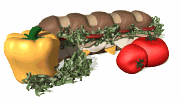
Middle Ages and Renaissance Italian Cookbooks
![]()
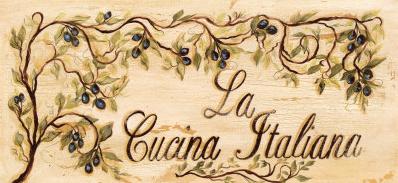
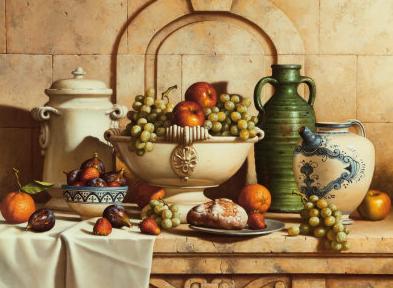


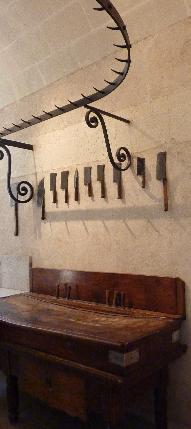
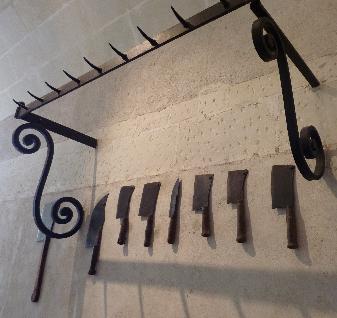
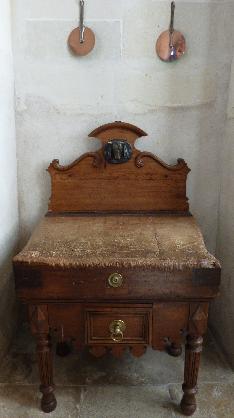
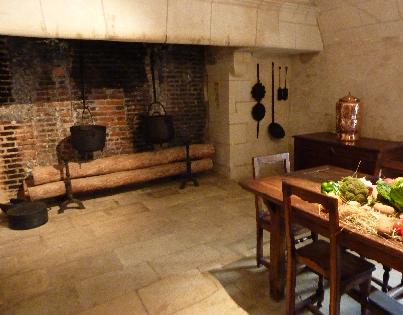
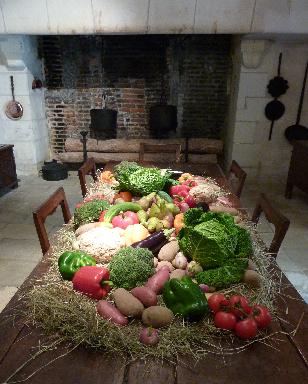
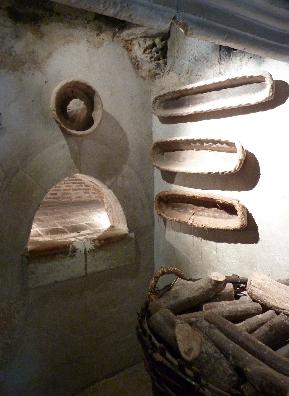
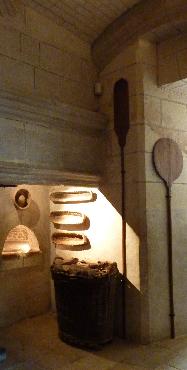
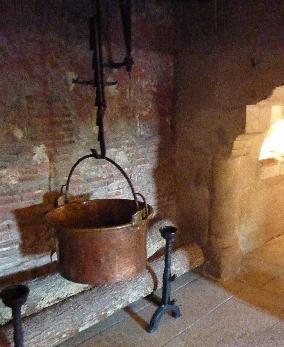
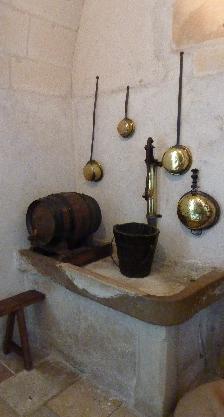
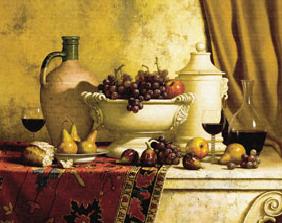
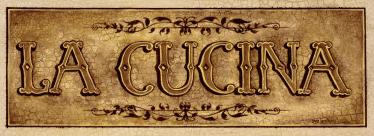
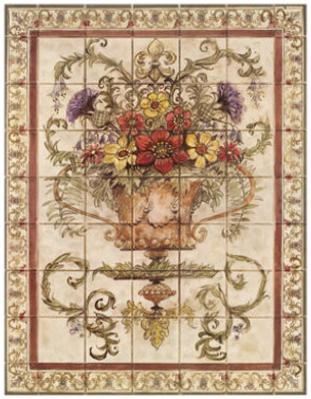
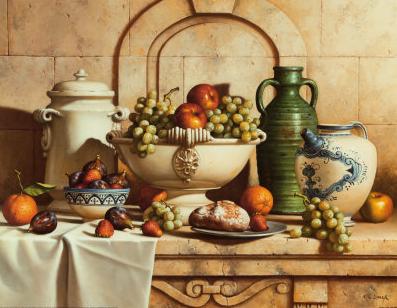
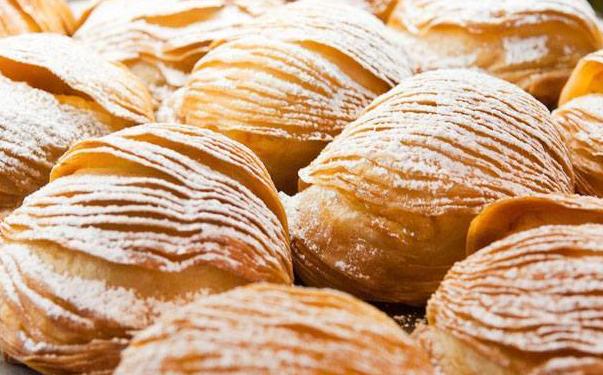

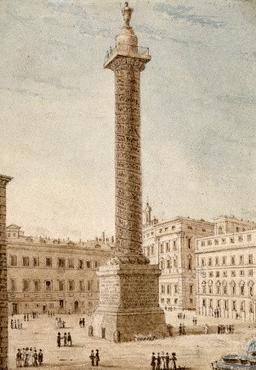
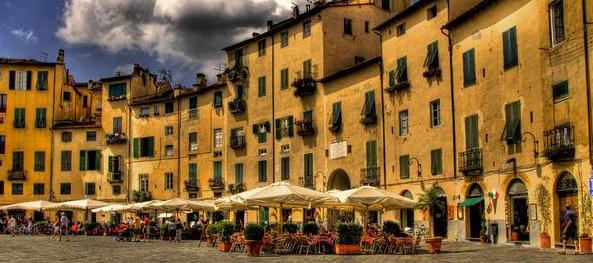

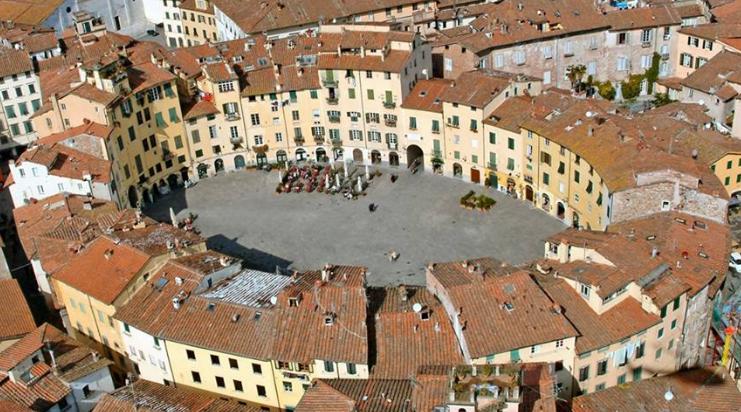

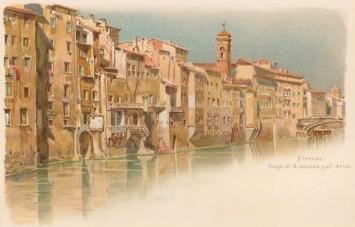
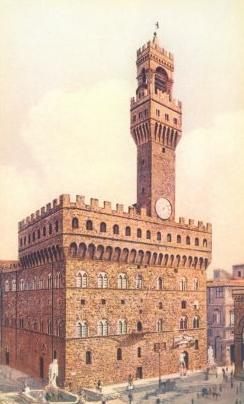

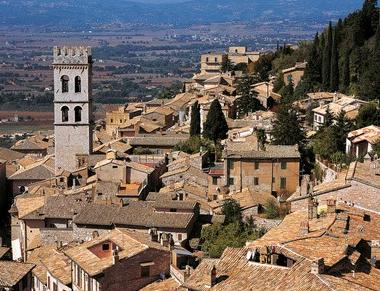
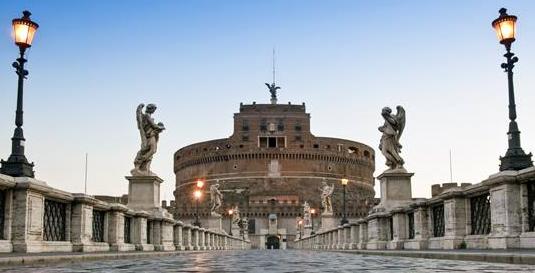






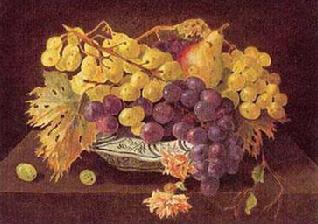
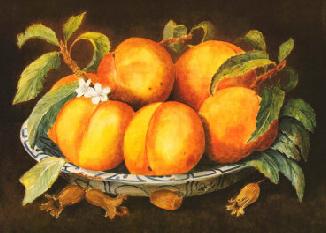

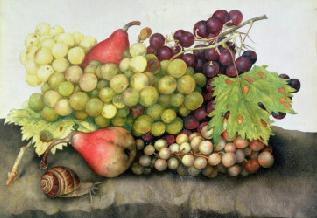
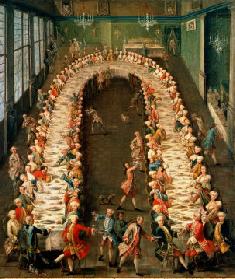
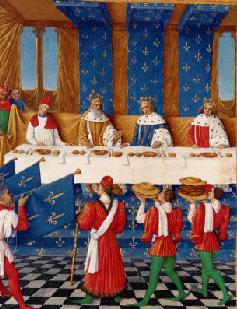
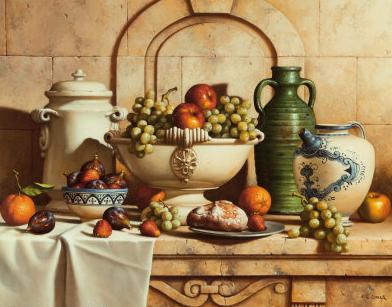

Manners, Customs, and Dress During the Middle Ages, and During the
Renaissance Period.
By Paul Lacroix
(Bibliophile Jacob),
Curator of the Imperial Library of the Arsenal, Paris.Illustrated with
Nineteen Chromolithographic Prints by F. Kellerhoven
and upwards of
Four Hundred Engravings on Wood.
Free On-line
This is the earliest
(circa 1380) and briefest (23 pages)
of the three books. The Italian is difficult to read if
you only know Italian because the language used has lots of Spanish
influence. 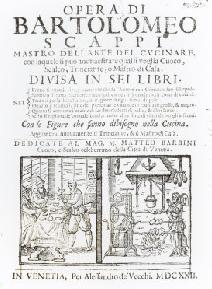
About These Books
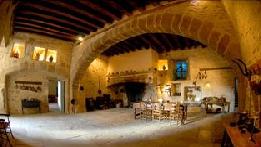

About the Era
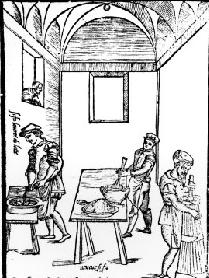

Spices and Herbs


Pizza and Pasta
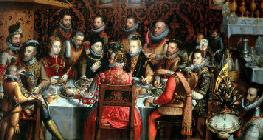
The Ingredients
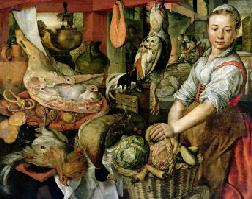

Coloring Food, and Banquets
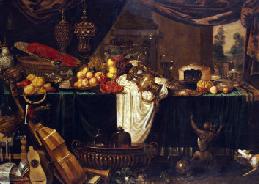
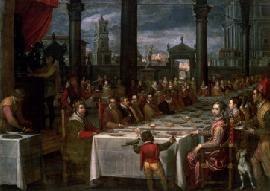
Medicine, and Tips and Tricks
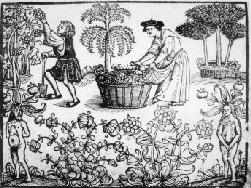
Some Other Things of Interest

From Amazon.com
English
Translations Available On-Line
Some images from
Scappi's (Platina's) book
